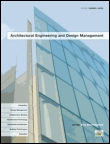
Architectural Engineering and Design Management
Scope & Guideline
Elevating architectural practices through cutting-edge research.
Introduction
Aims and Scopes
- Sustainable Building Practices:
Research addressing the design, construction, and operation of buildings that minimize environmental impact, focusing on energy efficiency, renewable materials, and sustainable technologies. - Building Information Modeling (BIM) Applications:
Exploring the use of BIM in various phases of building projects, including design, construction, and facility management, to enhance collaboration and efficiency. - Adaptive and Resilient Design Strategies:
Studies on adaptive design solutions that respond to climate change, urban density, and other environmental challenges, ensuring buildings are resilient and functional over time. - Healthcare and Emergency Design:
Research focused on the design and management of healthcare facilities and emergency spaces, emphasizing the importance of spatial planning in enhancing user experience and safety. - Digital Fabrication and Advanced Construction Techniques:
Investigation into the integration of digital technologies and fabrication methods in construction, including 3D printing, prefabrication, and modular construction. - Post-Occupancy Evaluation and User Experience:
Assessing the performance of buildings after occupancy to understand user satisfaction, comfort, and overall effectiveness of design features. - Historic Preservation and Adaptive Reuse:
Research aimed at the preservation of historic buildings and the strategies for their adaptive reuse, ensuring cultural heritage is maintained while meeting modern needs.
Trending and Emerging
- Integration of Technology and Design:
There is a growing emphasis on the integration of technologies such as BIM, AI, and digital fabrication into the design and construction processes, enhancing efficiency and collaboration. - Focus on Human-Centric Design:
Research increasingly prioritizes the human experience within built environments, exploring how design impacts user comfort, health, and well-being, particularly in healthcare and educational settings. - Resilience and Climate Adaptation Strategies:
An emerging focus on designing buildings that can adapt to climate change and extreme weather conditions, highlighting the need for resilience in architectural practices. - Sustainability through Circular Economy Principles:
A trend towards incorporating circular economy concepts in building design, emphasizing resource efficiency, waste reduction, and the reuse of materials. - Data-Driven Decision Making in Design:
The use of data analytics and modeling tools in architectural design is on the rise, facilitating informed decision-making and optimizing building performance. - Collaborative and Participatory Design Approaches:
Increasingly, research is exploring collaborative design processes that involve stakeholders, users, and communities in the decision-making process, enhancing the relevance and impact of design outcomes.
Declining or Waning
- Traditional Construction Methods:
There is a noticeable decrease in research focused on conventional construction techniques, as the industry shifts towards more innovative, technology-driven approaches such as modular construction and digital fabrication. - Basic Energy Efficiency Measures:
While energy efficiency remains a core theme, the focus has shifted from basic measures to more complex, integrated solutions that involve advanced technologies and systems thinking. - Single-Dimensional Sustainability Assessments:
Research that only addresses sustainability from a singular perspective (e.g., energy use) is becoming less prevalent, as holistic approaches that consider social, economic, and environmental factors gain importance. - Static Architectural Design Principles:
Interest in static design principles is waning in favor of dynamic, flexible design strategies that adapt to changing user needs and environmental conditions. - Generic Post-Occupancy Evaluations:
Research that does not incorporate specific contextual factors or user feedback in post-occupancy evaluations is declining, as there is a growing emphasis on tailored evaluations that consider diverse user experiences.
Similar Journals

Journal of Information Technology in Construction
Bridging the Gap Between IT and Construction ExcellenceThe Journal of Information Technology in Construction is a premier open-access journal dedicated to advancing knowledge in the intersection of information technology and construction practices. Established in 1996, this journal has emerged as a vital resource for researchers, professionals, and students in the fields of Building and Construction, Civil and Structural Engineering, and Computer Science Applications. Published by the INT COUNCIL RESEARCH & INNOVATION BUILDING & CONSTRUCTION, this journal's rigorous peer-reviewed content is designed to foster innovation and enhance the application of technological solutions within the construction sector. With a commendable reputation, the journal has secured Q1 ranking in Building and Construction and features in the top quartiles in related disciplines, ensuring its impact and relevance within academic and industrial communities. Conveniently accessible, the journal showcases high-quality research that influences both theoretical and practical aspects of construction technology, thereby contributing significantly to the field. Based in Sweden, the Journal of Information Technology in Construction stands as a crucial platform for disseminating insights that drive progress in this dynamic and evolving domain.
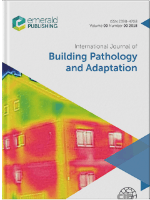
International Journal of Building Pathology and Adaptation
Exploring innovative pathways to building preservation.International Journal of Building Pathology and Adaptation is a premier publication dedicated to advancing knowledge in the field of building pathology and adaptation. Established by the esteemed Emerald Group Publishing Ltd, this journal serves as a vital platform for researchers and practitioners focusing on the assessment, preservation, and innovative adaptation of built environments. With an impressive Q2 ranking in both Building and Construction and Civil and Structural Engineering, and a Scopus ranking of #62 out of 223 in the relevant engineering disciplines, the journal showcases high-quality research with significant practical implications. Although currently not featuring an open-access model, its access options cater to a wide audience aiming to explore cutting-edge studies from 2017 to 2024. The journal's commitment to bridging the gap between academic inquiry and real-world application makes it an essential resource for anyone dedicated to advancing the resilience and sustainability of the built environment.
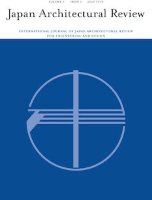
Japan Architectural Review
Navigating trends and challenges in modern architecture.Japan Architectural Review is a premier open-access journal published by WILEY, dedicated to advancing the fields of architecture, environmental engineering, and modeling and simulation. Since its inception, this journal has emerged as a critical platform for disseminating innovative research, offering insights into the latest trends and challenges facing the built environment and sustainability practices. With an impact factor reflecting its growing influence, especially in the Q2 category of Architecture and notable rankings in environmental engineering and modeling disciplines, it serves as an essential resource for researchers, professionals, and students alike. The journal's commitment to open access since 2018 has further enhanced its reach, making high-quality research accessible to a global audience. Spanning an important timeline from 2019 to 2024, the Japan Architectural Review facilitates a collaborative discourse among scholars, encouraging innovative solutions to contemporary architectural challenges.
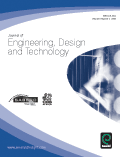
Journal of Engineering Design and Technology
Exploring the Frontiers of Engineering DesignJournal of Engineering Design and Technology, published by Emerald Group Publishing Ltd, is a prominent platform in the field of engineering, specializing in design and technology innovations. With an ISSN of 1726-0531, this journal has made significant contributions to the body of knowledge since its inception in 2005, offering rigorous peer-reviewed articles that cover a diverse range of topics from conceptual design to advanced engineering practices. As a Q2 journal in Engineering (miscellaneous), it stands out in the Scopus Rankings with a commendable position at #44 out of 307 and an impressive 85th percentile, reflecting its substantial impact in the engineering community. While currently not categorized as Open Access, the journal continues to pursue accessibility and engagement for researchers, professionals, and students alike, ensuring that influential research is disseminated effectively. As it converges towards 2024, the Journal of Engineering Design and Technology remains an essential resource for those advancing the scope of engineering innovations and technology-driven solutions.

Architect
Advancing Scholarly Dialogue in Design and ArchitectureArchitect is a publication dedicated to the diverse and evolving field of architecture and design, presented by the reputable HANLEY WOOD, LLC. Since its inception in 1975, the journal has traversed critical periods in architecture, offering valuable insights and research that cater to both practitioners and academics alike. The journal holds a Q4 ranking in both Architecture and Visual Arts and Performing Arts, indicating its niche presence within the crowded scholarly landscape. Despite its recent rankings within the Scopus, where it lies in the lower percentiles of the architecture category, the Architect journal provides platforms for innovative discussions and explorations in design, helping to shape the discourse in the architectural community. While the journal is currently accessible via traditional subscription models, it remains a critical resource for those seeking to bridge practice and theory in architecture. As it continues to evolve beyond its historical publication periods, Architect aims to nurture a rich environment for professional growth, scholarship, and dialogue among researchers, designers, and students engaged in the dynamic world of architecture.
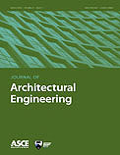
Journal of Architectural Engineering
Connecting Theory and Practice in Architectural EngineeringThe Journal of Architectural Engineering, published by the ASCE (American Society of Civil Engineers), stands as a pivotal resource in the interdisciplinary fields of architecture and engineering. With an ISSN of 1076-0431 and E-ISSN 1943-5568, this journal has garnered a notable reputation since its inception in 1995, currently converging towards 2024. Boasting a Q1 ranking in Architecture and Visual Arts and Performing Arts, alongside respectable Q3 rankings in Building and Construction and Civil and Structural Engineering, the journal places itself in the elite class of scholarly publications, evidenced by its impressive Scopus rankings. Its commitment to providing cutting-edge research ensures comprehensive coverage across various aspects of architectural engineering, facilitating robust interdisciplinary dialogues. Although the journal operates under a traditional access model, its impact on the academic community remains profound, making it an essential platform for researchers, professionals, and students who seek to push the boundaries of knowledge in their respective fields. This journal not only aims to stimulate innovative ideas but also fosters a collaborative environment for advancing sustainable architectural practices in a rapidly evolving built environment.

Advances in Civil and Architectural Engineering
Innovating Tomorrow's Infrastructure TodayAdvances in Civil and Architectural Engineering is a cutting-edge scholarly journal dedicated to the dissemination of pioneering research in the realm of civil engineering and architecture. Published by the esteemed Josip Juraj Strossmayer University of Osijek, Faculty of Civil Engineering and Architecture, this journal operates under an Open Access model since 2022, allowing for unrestricted access to its rich repository of articles. The journal aims to bridge the gap between academia and industry by providing a platform for innovative studies, technical advancements, and best practices that contribute to the evolution of sustainable construction and architectural design. With its focus on interdisciplinary approaches and contemporary challenges in the field, Advances in Civil and Architectural Engineering serves as an invaluable resource for researchers, professionals, and students seeking to enhance their understanding and impact in this vital area of engineering. The journal's ISSN is 2975-3848, and it is committed to fostering the advancement of knowledge and collaboration within the global engineering community.
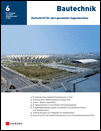
Bautechnik
Advancing construction knowledge for a sustainable future.Bautechnik is a premier academic journal in the fields of Building and Construction and Civil and Structural Engineering, published by ERNST & SOHN in Germany. With a history dating back to 1969 and a significant converged timeline through various years, this journal offers a rich repository of peer-reviewed research dedicated to advancing the principles, methodologies, and innovations within its domains. Bautechnik is currently ranked in the Q3 category for both building and construction, as well as civil and structural engineering, indicating its relevance and contribution to the academic community. Though it does not offer open access, its curated content is accessible to a global audience of researchers, professionals, and students striving for excellence in their fields. The journal aims to foster discussions and disseminate knowledge that impacts the future of construction, architecture, and engineering practices.
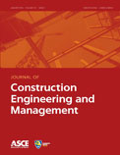
JOURNAL OF CONSTRUCTION ENGINEERING AND MANAGEMENT
Driving Progress in Construction Engineering and ManagementJournal of Construction Engineering and Management, published by the American Society of Civil Engineers (ASCE), is a premier scholarly journal dedicated to advancing the field of construction engineering and management. With an ISSN of 0733-9364 and an E-ISSN of 1943-7862, this respected journal boasts a noteworthy impact factor and is categorized in the Q1 quartile across significant fields such as Building and Construction, Civil and Structural Engineering, and Strategy and Management. Covering a broad spectrum of topics relevant to professionals, researchers, and students from its inception in 1982 through 2024, the journal emphasizes innovative research and practical applications that are vital to the construction industry. While it is not an open-access journal, it provides essential insights into the evolving dynamics of construction management, regulatory changes, and technological advancements, making it an indispensable resource for anyone looking to stay at the forefront of their field.
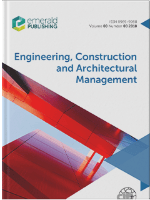
Engineering Construction and Architectural Management
Leading the Charge in Engineering and Construction ResearchEngineering Construction and Architectural Management is a prestigious journal published by Emerald Group Publishing Ltd, dedicated to advancing knowledge and practice at the intersection of engineering, architecture, and construction management. With an ISSN of 0969-9988 and an E-ISSN of 1365-232X, this journal fosters a scholarly environment for researchers, professionals, and students to explore innovative methodologies and developments within the field. Operating without Open Access, it has maintained a strong reputation since its inception in 1994, with a converged publication timeline extending to 2024. The journal proudly boasts a Q1 ranking in four critical categories for 2023, including Architecture and Building and Construction, highlighting its role as a leading source for groundbreaking research. Additionally, with impressive Scopus Rankings—such as #5 in Architecture (97th percentile) and #28 in Building and Construction (87th percentile)—it underscores its dedication to excellence in scholarly contributions. By addressing key challenges and emerging trends in the industry, Engineering Construction and Architectural Management serves as an essential resource for those striving to shape the future of engineering and architectural practices.